

Standard form helps us represent numbers and equations clearly and consistently. Let’s explore the concept in more detail!

Author
Michelle Griczika
Published
August 22, 2023


Standard form helps us represent numbers and equations clearly and consistently. Let’s explore the concept in more detail!

Author
Michelle Griczika
Published
August 22, 2023


Standard form helps us represent numbers and equations clearly and consistently. Let’s explore the concept in more detail!

Author
Michelle Griczika
Published
August 22, 2023


Key takeaways
Table of contents
Standard form is an important mathematical concept that helps us represent numbers and equations clearly and consistently. It may sound a bit technical, but don’t worry! In this article, we’ll explore standard form in a way that makes sense to elementary-level students like you.
Let’s start by understanding what standard form really means. Standard form is a special way of writing numbers or equations that helps us easily compare and work with them. In standard form, numbers are written as a multiplication of two parts: a number between 1 and 10 and a power of 10. Let’s break it down with some examples.
To write numbers in standard form, we follow a simple process. We identify the number between 1 and 10 and then determine how many times we need to multiply it by 10 to get the original number. Let’s take the number 5,000 as an example. We can write it in standard form as 5 x 10^3. The number 5 is between 1 and 10, and we multiply it by 10 three times to get 5,000.
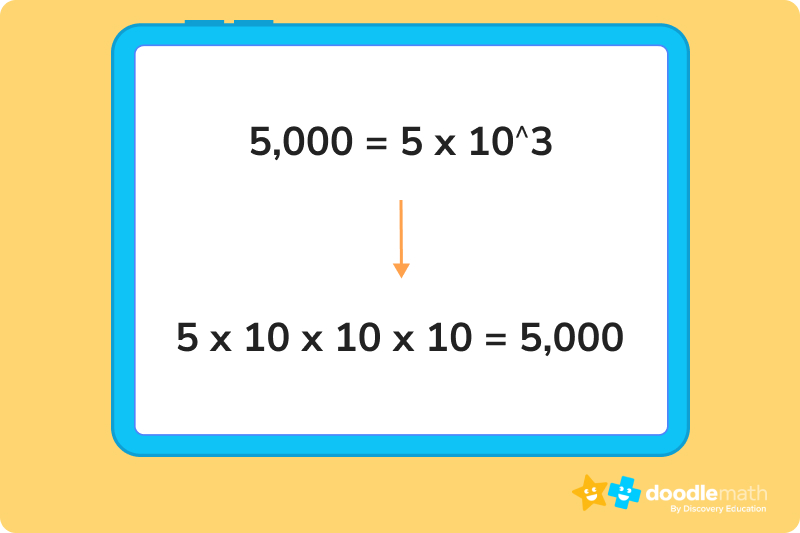
Unlock unlimited math questions
Put your skills to the test with fun exercises + maths games that are proven to boost ability!
Try DoodleMath for Free!
Select a grade
Now, let’s explore some advanced topics in standard form. Don’t worry if it seems a little challenging at first; understanding these concepts will help you as you progress in your mathematical journey.
You can also use standard form with fractions. When dealing with fractions, we can write the numerator and denominator in standard form separately. Here is one example of standard format: the fraction 3/20 can be expressed as 3 x 10^0 / 2 x 10^1. When we simplify it, we get 1.5 x 10^-1. It’s like magic!
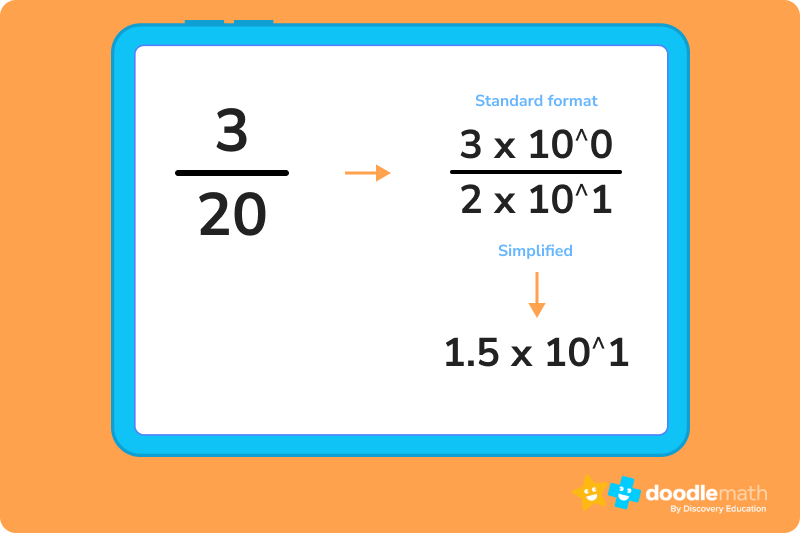
Equations can also be written in standard form. Let’s start with linear equations. In standard form, a linear equation looks like this: Ax + By = C. The letters A, B, and C represent numbers we need to find. Quadratic equations also have a standard form, written as Ax^2 + Bx + C = 0.
The standard form is represented in linear equations as Ax + By = C, where A, B, and C are constants. This form clearly lets us see the coefficients (the numbers multiplying x and y). For example, the equation 2x + 3y = 7 is in standard form. Therefore, we can easily compare the coefficients by writing equations in this form and see how x and y are related.
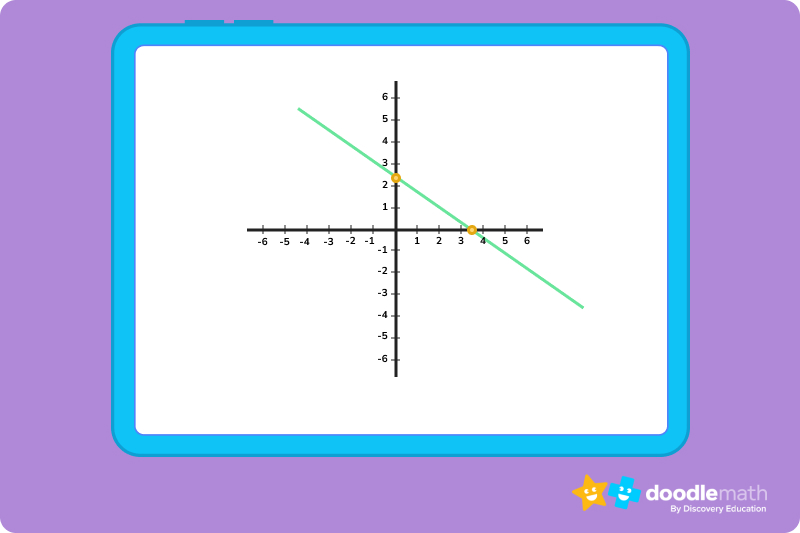
Quadratic equations also have a standard form, written as Ax^2 + Bx + C = 0. This form helps us identify the quadratic, linear, and constant coefficients. For instance, the equation x^2 – 5x + 6 = 0 is in standard form. By expressing quadratic equations this way, we can quickly recognize the coefficients and understand the behavior of the quadratic function.
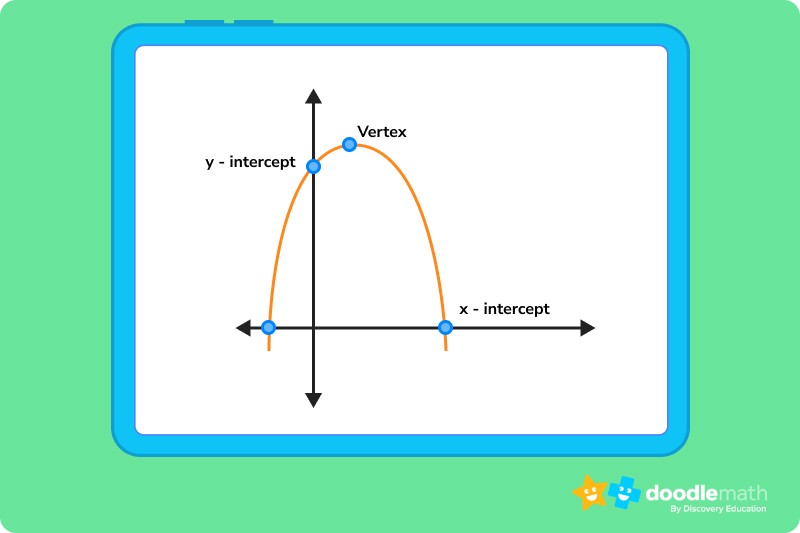
You can write polynomials with multiple terms in standard form too. We arrange the terms in descending order of their degree, which means the highest power comes first, followed by the others. For example, the polynomial 5x^2 – 2x^3 + 3x^4 – 7x + 1 can be written in standard form as 3x^4 – 2x^3 + 5x^2 – 7x + 1
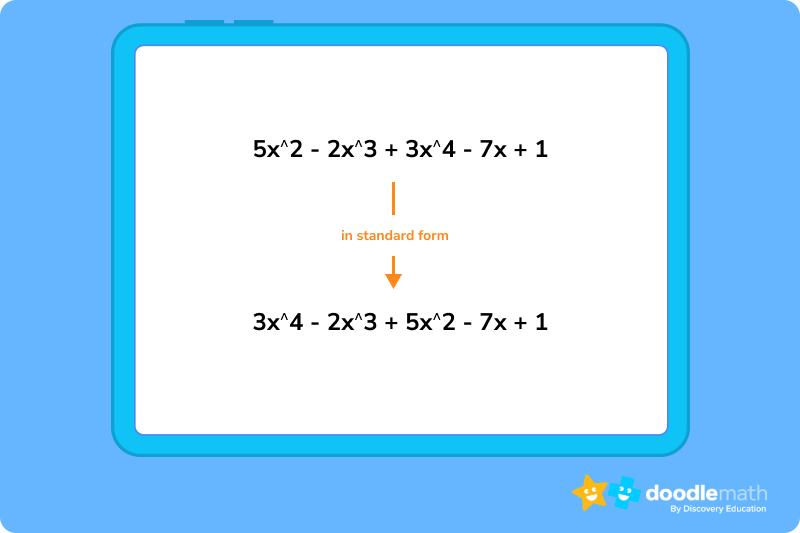
Explore numbers with DoodleMath
Want to learn more about standard form? DoodleMath is an award-winning math app that’s proven to double a child’s rate of progression with just 10 minutes of use a day!
Filled with fun, interactive questions aligned to state standards, Doodle creates a unique work program tailored to each child’s needs, boosting their confidence and skills in math. Try it for free today!


Congratulations! You’ve now gained a solid understanding of standard form — a powerful tool in mathematics.
Remember, standard form is all about breaking down numbers and equations into parts that are easy to understand and work with. Whether writing numbers in standard form, expressing fractions, or recognizing linear and quadratic equations, standard form simplifies how we communicate and solve mathematical problems.
If you want to further enhance your math skills in a fun and interactive way, check out DoodleLearning. The math app provides engaging activities and exercises that can help reinforce your understanding of standard form and many other math concepts.
To address common questions and misconceptions, let’s dive into some frequently asked questions about standard form:
Standard form in math refers to representing numbers or equations in a consistent format that includes a coefficient and a power of 10.
An example of standard form is 4.2 x 10^2, which represents the number 420.
Yes, standard form and scientific notation are the same concepts. Both involve writing numbers as a coefficient multiplied by a power of 10.

Lesson credits

Michelle Griczika
Michelle Griczika is a seasoned educator and experienced freelance writer. Her years teaching first and fifth grades coupled with her double certification in elementary and early childhood education lend depth to her understanding of diverse learning stages. Michelle enjoys running in her free time and undertaking home projects.

Michelle Griczika
Michelle Griczika is a seasoned educator and experienced freelance writer. Her years teaching first and fifth grades coupled with her double certification in elementary and early childhood education lend depth to her understanding of diverse learning stages. Michelle enjoys running in her free time and undertaking home projects.

Parents, sign up for a DoodleMath subscription and see your child become a math wizard!

Book a chat with our team
If you’d like to use Doodle’s browser version, please visit this page on a desktop.
To log in to Doodle on this device, you can do so through our apps. You can find out how to download them here: